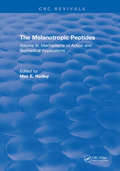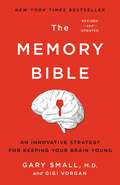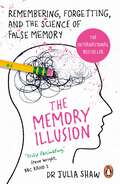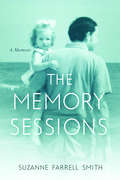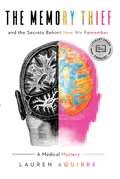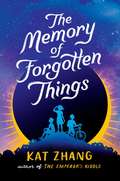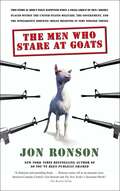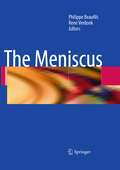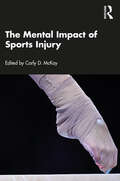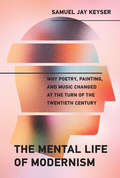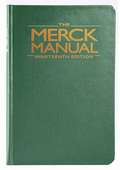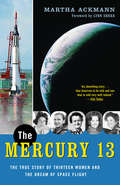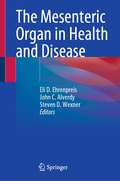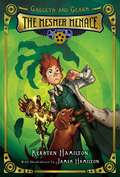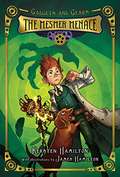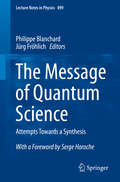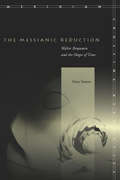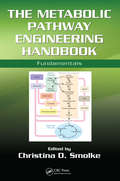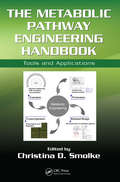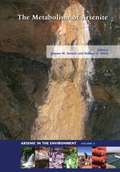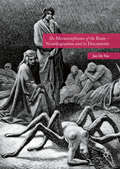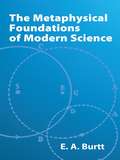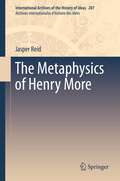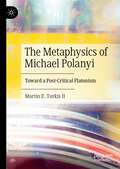- Table View
- List View
The Melanotropic Peptides: Volume III: Mechanisms of Action and Biomedical Applications
by M.E. HadleyThe three volumes on "The Melanotropic Peptides" are the outcome of a conference of the same name that was held in Tucson, Arizona, from October 11-12, 1986. Volume III discusses the known mechanisms of action of the two melanotropic peptides, and concludes with a discussion of the possible biomedical applications of the melanotropins.
The Memory Bible: An Innovative Strategy for Keeping Your Brain Young
by Gary Small Gigi VorganClear, concise, prescriptive steps for improving memory loss and keeping the brain young—from one of the world's top memory experts.Everybody forgets things sometimes—from your keys to your lunch date to the name of an acquaintance. According to Dr. Gary Small, the director of the UCLA Center on Aging, much of this forgetfulness can be eliminated easily through his innovative memory exercises and brain fitness program—now available for the first time in a book. Using Small's recent scientific discoveries, The Memory Bible can immediately improve your mental performance. One of the ten commandments that Dr. Small has pioneered to improve your memory immediately is LOOK, SNAP, CONNECT:1: LOOK: actively observe what you want to learn2: SNAP: create a vivid snapshot and memorable image3: CONNECT: visualize a link to associate imagesIn addition, Dr. Small's comprehensive program includes a "brain diet" of memory-enhancing foods and a list of the most effective drugs, as well as a workbook with a weekly and daily calendar. Remember, as Dr. Small says, "Great memories are not born, they are made."
The Memory Illusion: Remembering, Forgetting, and the Science of False Memory
by Dr Julia ShawTHE INTERNATIONAL BESTSELLER'Truly fascinating.' Steve Wright, BBC Radio 2- Have you ever forgotten the name of someone you’ve met dozens of times?- Or discovered that your memory of an important event was completely different from everyone else’s?- Or vividly recalled being in a particular place at a particular time, only to discover later that you couldn’t possibly have been?We rely on our memories every day of our lives. They make us who we are. And yet the truth is, they are far from being the accurate record of the past we like to think they are. In The Memory Illusion, forensic psychologist and memory expert Dr Julia Shaw draws on the latest research to show why our memories so often play tricks on us – and how, if we understand their fallibility, we can actually improve their accuracy. The result is an exploration of our minds that both fascinating and unnerving, and that will make you question how much you can ever truly know about yourself. Think you have a good memory? Think again.'A spryly paced, fun, sometimes frightening exploration of how we remember – and why everyone remembers things that never truly happened.' Pacific Standard
The Memory Sessions
by Suzanne Farrell SmithSuzanne Farrell Smith’s father was killed by a drunk driver when she was six, and a devastating fire nearly destroyed her house when she was eight. She remembers those two—and only those two—events from her first nearly twelve years of life. While her three older sisters hold on to rich and rewarding memories of their father, Smith recalls nothing of him. Her entire childhood was, seemingly, erased. In The Memory Sessions, Smith attempts to excavate lost childhood memories. She puts herself through multiple therapies and exercises, including psychotherapy, hypnotherapy, somatic experiencing, and acupuncture. She digs for clues in her mother’s long-stored boxes. She creates—with objects, photographs, and captions—a physical timeline to compensate for the one that’s missing in her memory. She travels to San Diego, where her family vacationed with her father right before he died. She researches, interviews, and meditates, all while facing down the two traumatic memories that defined her early life. The result is an experimental memoir that upends our understanding of the genre. Rather than recount a childhood, The Memory Sessions attempts to create one from research, archives, imagination, and the memories of others. Published by Bucknell University Press. Distributed worldwide by Rutgers University Press.
The Memory Thief: The Secrets Behind How We Remember—A Medical Mystery
by Lauren AguirreThe remarkable true story of a team of doctors who – through years of scientific sleuthing and observant care—discover a surprising connection between opioids and memory, one that holds promise and peril for any one of us.How could you lose your memory overnight, and what would it mean? The day neurologist Jed Barash sees the baffling brain scan of a young patient with devastating amnesia marks the beginning of a quest to answer those questions. First detected in a cluster of stigmatized opioid overdose victims in Massachusetts with severe damage to the hippocampus—the brain&’s memory center—this rare syndrome reveals how the tragic plight of the unfortunate few can open the door to advances in medical science. After overcoming initial skepticism that investigating the syndrome is worth the effort—and that fentanyl is the likely culprit—Barash and a growing team of dedicated doctors explore the threat that people who take opioids chronically as prescribed to treat severe pain may gradually put their memories at risk. At the same time, they begin to grasp the potential for this syndrome to shed light on the most elusive memory thief of all—Alzheimer&’s disease. Through the prism of this fascinating story, Aguirre goes on to examine how researchers tease out the fundamental nature of memory and the many mysteries still to be solved. Where do memories live? Why do we forget most of what happens in a day but remember some events with stunning clarity years later? How real are our memories? And what purpose do they actually serve? Perhaps the greatest mystery in The Memory Thief is why Alzheimer&’s has evaded capture for a century even though it afflicts tens of millions around the world and lies in wait for millions more. Aguirre deftly explores this question and reveals promising new strategies and developments that may finally break the long stalemate in the fight against this dreaded disease. But at its core, Aguirre&’s genre-bending and deeply-reported book is about paying attention to the things that initially don&’t make sense—like the amnestic syndrome—and how these mysteries can move science closer to an ever-evolving version of the truth.
The Memory of Forgotten Things
by Kat ZhangIn the tradition of The Thing About Jellyfish and When You Reach Me, acclaimed author Kat Zhang offers a luminous and heartbreaking novel about a girl who is convinced that an upcoming solar eclipse will bring back her dead mother. <P><P>One of the happiest memories twelve-year-old Sophia Wallace has is of her tenth birthday. Her mother made her a cake that year—and not a cake from a boxed-mix, but from scratch. She remembers the way the frosting tasted, the way the pink sugar roses dissolved on her tongue. This memory, and a scant few others like it, is all Sophia has of her mother, so she keeps them close. She keeps them secret, too. Because as paltry as these memories are, she shouldn’t have them at all. The truth is, Sophia Wallace’s mother died when she was six years old. But that isn’t how she remembers it. Not always. Sophia has never told anyone about her unusual memories—snapshots of a past that never happened. But everything changes when Sophia’s seventh grade English class gets an assignment to research solar eclipses. She becomes convinced that the upcoming solar eclipse will grant her the opportunity to make her alternate life come true, to enter a world where her mother never died. <P><P>With the help of two misfit boys, she must figure out a way to bring her mother back to her—before the opportunity is lost forever.
The Men Who Stare at Goats
by Jon RonsonBizarre military history: In 1979, a crack commando unit was established by the most gifted minds within the U.S. Army. Defying all known laws of physics and accepted military practice, they believed that a soldier could adopt the cloak of invisibility, pass cleanly through walls, and--perhaps most chillingly--kill goats just by staring at them. They were the First Earth Battalion, entrusted with defending America from all known adversaries. And they really weren't joking. What's more, they're back--and they're fighting the War on Terror. An uproarious exploration of American military paranoia: With investigations ranging from the mysterious "Goat Lab," to Uri Geller's covert psychic work with the CIA, to the increasingly bizarre role played by a succession of U.S. presidents, this might just be the funniest, most unsettling book you will ever read--if only because it is all true and is still happening today.
The Meniscus
by Philippe Beaufils René VerdonkThis clinical guide provides a special focus on the normal meniscal mechanism, body and function. Meniscal pathology and therapy are depicted in detail, followed by the presentation of long-term experience of meniscal transplantation and a look into the future of meniscal surgery. During the last few decades, as the management of meniscal trauma has evolved, and knowledge gained on meniscal function, the orthopaedic surgeon has attempted to preserve the meniscus whenever possible. Arthroscopic meniscal repair has become the treatment of choice when the tear is located in the peripheral rim. Partial meniscectomy has become limited to such an extent that the deleterious effect of total meniscectomy is avoided. Meniscal allograft replacement, which has been available for the last two decades, is used when the patient is confronted with a painful total meniscectomy. Future research and experiments may suggest that partial meniscal replacement might be indicated in the presence of a painful knee compartment after failed meniscal repair or partial meniscectomy.
The Mental Impact of Sports Injury
by Carly D. McKayMuch is known about the physical strain that athletes’ bodies are subjected to and the dangerous aspects of competition immediately spring to mind. But why do athletes train the way they do, and why do they push the limits? Why do some recover well from injury while others struggle? Despite decades of medical and sport science research, a piece has been missing from this picture. Until recently, the role of psychological factors in risk and rehabilitation has been poorly understood. Thankfully, there is increasing awareness of just how crucial these factors can be for predicting injury, improving recovery, developing prevention strategies, and supporting athletes’ long-term health. Yet, research in this area is still in its infancy and it can be difficult to synthesize an ever-growing body of knowledge into practical injury management approaches. Using analogies from everyday life, The Mental Impact of Sports Injury bridges the gap between academic research and practical settings in an informative, yet easy to follow guide to the psychology of sports injury. Addressing risk, rehabilitation, and prevention, it outlines key considerations for researchers and practitioners across all levels of sport. Alongside the fundamentals of injury psychology, emerging areas of importance are also discussed, including training load monitoring and the technological advances that are shaping modern sport medicine. Targeted examples highlight the challenges of preventing and managing injury in grassroots, elite, and professional contexts, with chapters dedicated to the under-served communities of youth and Para sport athletes. Stepping away from traditional texts, this unique book presents the landmark literature, major concepts, and athlete insights into sports injury psychology from a totally new perspective.
The Mental Life of Modernism: Why Poetry, Painting, and Music Changed at the Turn of the Twentieth Century
by Samuel Jay KeyserAn argument that Modernism is a cognitive phenomenon rather than a cultural one.At the beginning of the twentieth century, poetry, music, and painting all underwent a sea change. Poetry abandoned rhyme and meter; music ceased to be tonally centered; and painting no longer aimed at faithful representation. These artistic developments have been attributed to cultural factors ranging from the Industrial Revolution and the technical innovation of photography to Freudian psychoanalysis. In this book, Samuel Jay Keyser argues that the stylistic innovations of Western modernism reflect not a cultural shift but a cognitive one. Behind modernism is the same cognitive phenomenon that led to the scientific revolution of the seventeenth century: the brain coming up against its natural limitations. Keyser argues that the transformation in poetry, music, and painting (the so-called sister arts) is the result of the abandonment of a natural aesthetic based on a set of rules shared between artist and audience, and that this is virtually the same cognitive shift that occurred when scientists abandoned the mechanical philosophy of the Galilean revolution. The cultural explanations for Modernism may still be relevant, but they are epiphenomenal rather than causal. Artists felt that traditional forms of art had been exhausted, and they began to resort to private formats—Easter eggs with hidden and often inaccessible meaning. Keyser proposes that when artists discarded their natural rule-governed aesthetic, it marked a cognitive shift; general intelligence took over from hardwired proclivity. Artists used a different part of the brain to create, and audiences were forced to play catch up.
The Merck Manual of Diagnosis and Therapy
by Robert S. PorterThe world's most widely used medical reference is now better than ever For its 19th Edition, the Merck Manual of Diagnosis and Therapy has been thoroughly updated and thoughtfully expanded, with more than 850 additional pages, 15 new chapters, over 300 new tables, and 56 new figures. Packed with essential information on diagnosing and treating medical disorders, this handy, compact guide was written by a team of clinicians for everyday use by medical professionals for delivery of the best care to their patients. Designed for maximum clinical utility, the new Merck Manual of Diagnosis and Therapy 19th edition makes it easy to find the right information, right when it is needed. It is a must-have for medical students, residents, practicing physicians, nurses, and allied health professionals.
The Mercury 13: The Untold Story of Thirteen American Women and the Dream of Space Flight
by Martha AckmannFor readers of The Astronaut Wives Club, The Mercury 13 reveals the little-known true story of the remarkable women who trained for NASA space flight. <p><p> In 1961, just as NASA launched its first man into space, a group of women underwent secret testing in the hopes of becoming America’s first female astronauts. They passed the same battery of tests at the legendary Lovelace Foundation as did the Mercury 7 astronauts, but they were summarily dismissed by the boys’ club at NASA and on Capitol Hill. The USSR sent its first woman into space in 1963; the United States did not follow suit for another twenty years. <p><p> For the first time, Martha Ackmann tells the story of the dramatic events surrounding these thirteen remarkable women, all crackerjack pilots and patriots who sometimes sacrificed jobs and marriages for a chance to participate in America’s space race against the Soviet Union. In addition to talking extensively to these women, Ackmann interviewed Chuck Yeager, John Glenn, Scott Carpenter, and others at NASA and in the White House with firsthand knowledge of the program, and includes here never-before-seen photographs of the Mercury 13 passing their Lovelace tests. <p><p> Despite the crushing disappointment of watching their dreams being derailed, the Mercury 13 went on to extraordinary achievement in their lives: Jerrie Cobb, who began flying when she was so small she had to sit on pillows to see out of the cockpit, dedicated her life to flying solo missions to the Amazon rain forest; Wally Funk, who talked her way into the Lovelace trials, went on to become one of the first female FAA investigators; Janey Hart, mother of eight and, at age forty, the oldest astronaut candidate, had the political savvy to steer the women through congressional hearings and later helped found the National Organization for Women. <p><p> A provocative tribute to these extraordinary women, The Mercury 13 is an unforgettable story of determination, resilience, and inextinguishable hope.
The Mesenteric Organ in Health and Disease
by Eli D. Ehrenpreis Steven D. Wexner John C. AlverdyRecent discoveries and clarifications of known information about the mesentery have now established that these complex structures function together as an individual organ within the human body. As such, conditions that affect the mesentery can now be grouped within a single area of study and clinical practice. The various aspects of mesenteric diseases have not been brought together in a single source and this book aims to bring them together for the first time. It will cover general areas such as anatomy, histology and physiology of the mesentery. A description of diagnostic procedures used to evaluate patients with mesenteric disorders will follow. A practical survey with detailed descriptions of medical, surgical, and neoplastic disorders of the mesentery is also be included. This book is intended to be a guide for clinical practitioners including gastroenterologists, general surgeons, colorectal surgeons, primary care physicians, nurse practitioners and physician assistants who manage patients with mesenteric disorders.
The Mesmer Menace
by James Hamilton Kersten HamiltonWelcome to the Amazing Automated Inn, home of twelve-year-old inventor Wally Kennewickett, his genius scientist parents, and his dashing dog, Noodles. From the lightning harvester on the roof to the labs full of experiments in the dungeon, the inn is a wonderful place for a curious boy and his loyal dog to live. That is, until President Theodore Roosevelt himself calls the elder Kennewicketts away, leaving Wally and Noodles to face the evil Mesmers, horrible hypnotists bent on controlling the minds of powerful people. It seems the inn is their first stop on the way to world domination . . . and only an ingenious boy, a staff of automatons, and a brave dachshund stand in their way!
The Mesmer Menace: Gadget and Gears #1 (Into Reading, Trade Book #2)
by James Hamilton Kersten HamiltonNIMAC-sourced textbook <P><P>Welcome to the Amazing Automated Inn, home of twelve-year-old inventor Wally Kennewickett, his genius scientist parents, and his dashing dog, Noodles. From the lightning harvester on the roof to the labs full of experiments in the dungeon, the inn is a wonderful place for a curious boy and his loyal dog to live. That is, until President Theodore Roosevelt himself calls the elder Kennewicketts away, leaving Wally and Noodles to face the evil Mesmers, horrible hypnotists bent on controlling the minds of powerful people. It seems the inn is their first stop on the way to world domination . . . and only an ingenious boy, a staff of automatons, and a brave dachshund stand in their way!
The Message of Quantum Science
by Philippe Blanchard Jürg FröhlichThis collection of essays is above all intended to pay tribute to the fact that while QM today is a refined and incredibly successful instrument, many issues concerning the internal consistency and the interpretation of this theory are still not nearly as well understood as they ought to be. In addition, whenever possible these essays take the opportunity to link foundational issues to the many exciting developments that are often linked to major experimental and technological breakthroughs in exploiting the electromagnetic field and in particular, its quantum properties and its interactions with matter, as well as to advances in solid state physics (such as new quantum Hall liquids, topological insulators and graphene). The present volume also focuses on various areas, including new interference experiments with very large molecules passing through double-slits, which test the validity of the Kochen-Specker theorem; new tests of the violation of Bell's inequalities and the consequences of entanglement; new non-demolition measurements and tests of "wave-function collapse" to name but a few. These experimental developments have raised many challenging questions for theorists, leading to a new surge of interest in the foundations of QM, which have puzzled physicists ever since this theory was pioneered almost ninety years ago. The outcome of a seminar program of the same name on foundational issues in quantum physics (QM), organized by the editors of this book and addressing newcomers to the field and more seasoned specialists alike, this volume provides a pedagogically inspired snapshot view of many of the unresolved issues in the field of foundational QM.
The Messianic Reduction: Walter Benjamin and the Shape of Time
by Peter FenvesThe Messianic Reduction is a groundbreaking study of Walter Benjamin's thought. Fenves places Benjamin's early writings in the context of contemporaneous philosophy, with particular attention to the work of Bergson, Cohen, Husserl, Frege, and Heidegger. By concentrating on a neglected dimension of Benjamin's friendship with Gershom Scholem, who was a student of mathematics before he became a scholar of Jewish mysticism, Fenves shows how mathematical research informs Benjamin's reflections on the problem of historical time. In order to capture the character of Benjamin's "entrance" into the phenomenological school, the book includes a thorough analysis of two early texts he wrote under the title of "The Rainbow," translated here for the first time. In its final chapters, the book works out Benjamin's deep and abiding engagement with Kantian critique, including Benjamin's discovery of the political counterpart to the categorical imperative in the idea of "pure violence."
The Metabolic Pathway Engineering Handbook: Fundamentals
by Christina D. SmolkeThis first volume of the Metabolic Pathway Engineering Handbook provides an overview of metabolic pathway engineering with a look towards the future. It discusses cellular metabolism, including transport processes inside the cell and energy generating reactions, as well as rare metabolic conversions. This volume also explores balances and reaction
The Metabolic Pathway Engineering Handbook: Tools and Applications
by Christina D. SmolkeThis second volume of the Metabolic Pathway Engineering Handbook delves into evolutionary tools and gene expression tools for metabolic pathway engineering. It covers applications of emerging technologies including recent research genome-wide technologies, DNA and phenotypic microarrays, and proteomics tools for experimentally determining flux thro
The Metabolism of Arsenite (Arsenic in the environment)
by Joanne M. Santini; Seamus A. WardUp to 200 million people in 70 countries are at risk from drinking water contaminated with arsenic, which is a major cause of chronic debilitating illnesses and fatal cancers. Until recently little was known about the mobility of arsenic, and how redox transformations determined its movement into or out of water supplies. Although human activities contribute to the release of arsenic from minerals, it is now clear that bacteria are responsible for most of the redox transformation of arsenic in the environment. Bacterial oxidation of arsenite (to the less mobile arsenate) has been known since 1918, but it was not until 2000 that a bacterium was shown to gain energy from this process. Since then a wide range of arsenite-oxidizing bacteria have been isolated, including aerobes and anaerobes; heterotrophs and autotrophs; thermophiles, mesophiles and psychrophiles. This book reviews recent advances in the study of such bacteria. After a section on background—geology and health issues—the main body of the book concerns the cellular machinery of arsenite oxidation. It concludes by examining possible applications. Topics treated are: The geology and cycling of arsenic Arsenic and disease Arsenite oxidation: physiology, enzymes, genes, and gene regulation. Community genomics and functioning, and the evolution of arsenite oxidation Microbial arsenite oxidation in bioremediation Biosensors for arsenic in drinking water and industrial effluents
The Metamorphoses of the Brain - Neurologisation and its Discontents
by Jan De VosWhat are we exactly, when we are said to be our brain? This question leads Jan De Vos to examine the different metamorphoses of the brain: the educated brain, the material brain, the iconographic brain, the sexual brain, the celebrated brain and, finally, the political brain. This first, protracted and sustained argument on neurologisation, which lays bare its lineage with psychologisation, should be taken seriously by psychologists, educationalists, sociologists, students of cultural studies, policy makers and, above all, neuroscientists themselves.
The Metaphysical Foundations of Modern Science
by E. A. BurttTo the medieval thinker, man was the center of creation and all of nature existed purely for his benefit. The shift from the philosophy of the Middle Ages to the modern view of humanity’s less central place in the universe ranks as the greatest revolution in the history of Western thought, and this classic in the philosophy of science describes and analyzes how that profound change occurred. A fascinating analysis of the works of Copernicus, Kepler, Galileo, Descartes, Hobbes, Gilbert, Boyle, and Newton, it not only establishes the reasons for the triumph of the modern perspective, but also accounts for certain limitations in this view that continue to characterize contemporary scientific thought. A criticism as well as a history of the change that made possible the rise of modern science, this volume is also a guide to understanding the methods and accomplishments of the great philosopher-scientists of the sixteenth and seventeenth centuries.
The Metaphysics and Mathematics of Arbitrary Objects
by Leon HorstenBuilding on the seminal work of Kit Fine in the 1980s, Leon Horsten here develops a new theory of arbitrary entities. He connects this theory to issues and debates in metaphysics, logic, and contemporary philosophy of mathematics, investigating the relation between specific and arbitrary objects and between specific and arbitrary systems of objects. His book shows how this innovative theory is highly applicable to problems in the philosophy of arithmetic, and explores in particular how arbitrary objects can engage with the nineteenth-century concept of variable mathematical quantities, how they are relevant for debates around mathematical structuralism, and how they can help our understanding of the concept of random variables in statistics. This fully worked through theory will open up new avenues within philosophy of mathematics, bringing in the work of other philosophers such as Saul Kripke, and providing new insights into the development of the foundations of mathematics from the eighteenth century to the present day.
The Metaphysics of Henry More
by Jasper ReidThe book surveys the key metaphysical contributions of the Cambridge Platonist, Henry More (1614-1687). It deals with such interwoven topics as: the natures of body and spirit, and the question of whether or not there is a sharp ontological division between them; the nature of spatial extension in relation to each; the composition and governance of the physical world, including More's theories of Hyle, atoms, vacuum, and the Spirit of Nature; and the life of the human soul, including its pre-existence. It approaches these topics and the systematic connections between them both historically and analytically, and seeks to do justice to the ways in which More's system developed and changed--sometimes quite dramatically--over the course of his long career. It also explores More's intellectual relations with both his own inspirations (Plotinus, Origen, Ficino, Descartes, etc.) and with those who responded, whether positively or negatively, to his work (Leibniz, Locke, Boyle, Newton, etc.).
The Metaphysics of Michael Polanyi: Toward a Post-Critical Platonism
by Martin E. Turkis IIThis book tells the story of how the Platonic vision of Michael Polanyi – the Hungarian-British chemist and philosopher – bridges the gap between speculative metaphysics and scientific practice, thus making sense of the broad swathe of human experience in a phenomenologically satisfying fashion. The central proposal is that Polanyi is a Platonist due to his affirmation of the ontological status of abstract objects, with particular focus placed on the question of uninstantiated universals. The book engages contemporary, speculative realists from both continental and analytic traditions as it introduces Polanyi’s influential epistemology and unpacks the fascinating metaphysics implied thereby. It then proceeds to develop Polanyi’s rather unsystematic metaphysics into a coherent, post-critical Platonism which incorporates his well-known theory of tacit knowledge, thus achieving something akin to the ancient Neoplatonic synthesis of Plato and Aristotle in our contemporary, scientific context.
